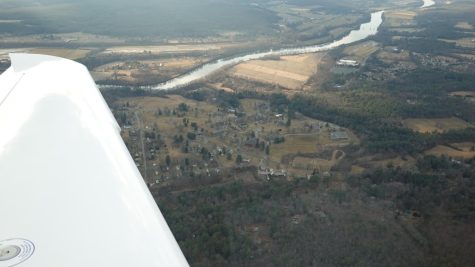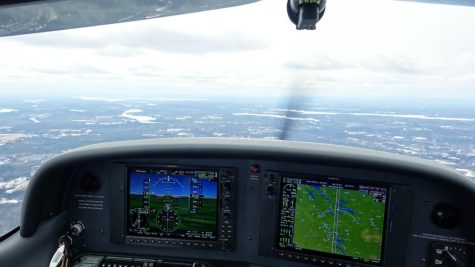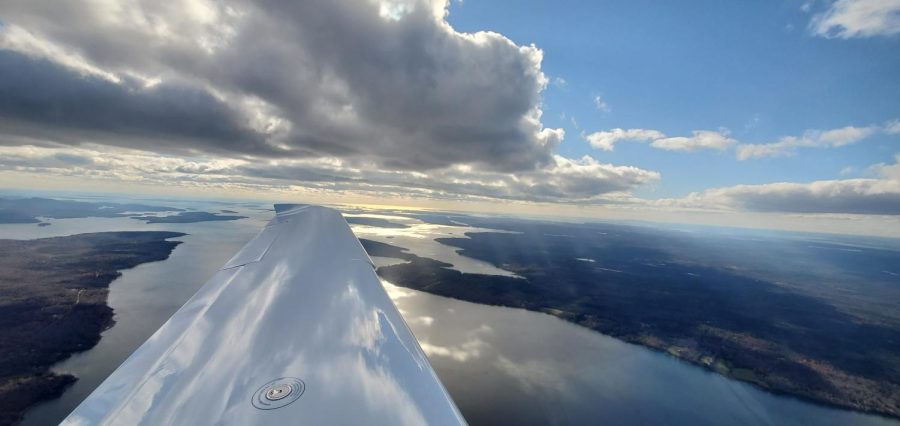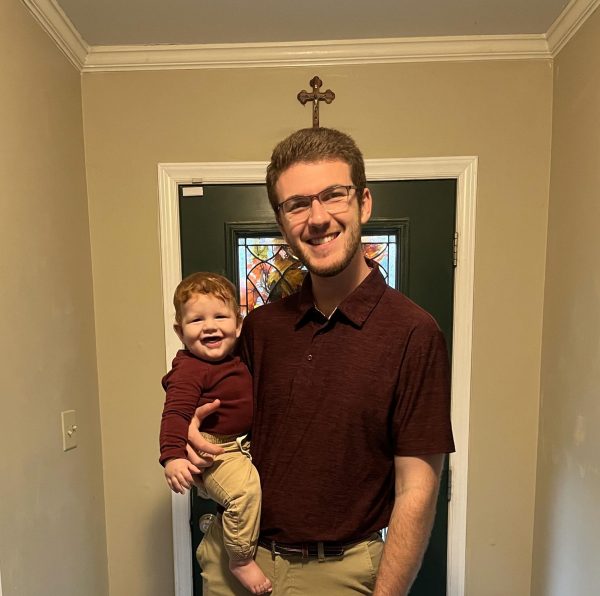Student Spotlight: Marc Wagner
It’s a bird! It’s a plane! No, it’s Marc Wagner! Read on to discover what it’s like to fly and pursue a pilot’s license as a MODG senior.
First off, tell us about the first time you ever flew.
The first time I ever flew was on 10-10-18 in a Cessna 172. In this first orientation flight my instructor demonstrated, and subsequently taught, the basics of handling the aircraft such as: straight and level flight (harder than you might think), standard turns, climbs, and descents. Initially, when we started climbing away from the ground it felt surreal. It felt like as if you had driven your car off a cliff but instead of going down, you’re going up rapidly. As you can imagine this might make some people panic but fortunately I did not. After about 5 minutes or so, as I got higher, the feeling of surreality wore off. After that, my instructor started letting me handle the aircraft. At that point, controlling the aircraft gave me a huge sense of accomplishment and freedom.
How long have you wanted to become a pilot?

I’ve always wanted to become a pilot since I started playing with remote control drones when I was around eight years old.
What made you want to pursue a pilot’s license?
My interest for flying itself made me want to pursue a pilot’s license and my father encouraged it.
What requirements (age, time, classes) are needed to earn a pilot’s license?
The list of requirements to become a private pilot is very lengthy, but to summarize as described in FAR Part 61.109(a):
You must complete a ground school and score at least a 70% on a written practical test.
Complete the required flight hours including:
-40 hours of flight time,
-20 hours of dual flight training
-10 hours of solo flight time
-3 hours of cross country flight training
-5 hours of solo cross country
-One solo cross country flight of 150 nautical miles total distance, with full-stop landings at three points, and one segment of the flight consisting of a straight-line distance of more than 50 nautical miles between the takeoff and landing locations
-3 solo take off and landings at a towered airport
-3 hours of night flight time
-Night cross country flight of at least 100nm total distance
-10 takeoffs and landings to a full stop at night
– 3 hours of instrument flight time
After this, you qualify for a “check ride”; this is essentially a driving test for pilots.
In the check ride, a designated pilot examiner (DPE) tests you on your Aeronautical knowledge, first on the ground orally and then in flight. The oral practical exam usually takes 1.5 to 2 or even 3 hours. The flight portion usually takes about 2 hours. The DPE must determine if the pilot abides by the Airmen Certification Standards and if the pilot does, they may receive their Private Pilot’s License.
Part 61.109: https://www.law.cornell.edu/cfr/text/14/61.109
Airmen Certification Standards (for private pilot): https://www.faa.gov/training_testing/testing/acs/media/private_airplane_acs_change_1.pdf
What is the hardest part about flying?
The hardest part about flying is ironically not flying at all. The preparation for a flight can be lengthy and tedious. In short, you need to plan for NOTAMs (Notices to Airmen), weather, known ATC (Air Traffic Controller) delays, runways, A\alternatives, fuel requirements, takeoffs, and landings. Each of these categories can take a while.
Compare flying a plane to driving a car. What are the similarities and differences?
Cars have steering wheels. Airplanes have yokes. The yoke of the aircraft controls the ailerons and elevator. On the ground, unlike a car, the plane is steered using the rudder pedals. In the Cirrus SR20 (the plane I’m flying in currently), you steer on the ground by first gaining some speed, and then, tapping on the very top of the rudder pedals, apply break pressure to one of the left or right rear wheels. These wheels don’t turn at all but rather use their brakes to steer the aircraft on the taxiway. In flight, planes aren’t really at all similar to cars. Planes while flying have 3D characteristics while cars only have 2D.
What is the scariest situation you’ve ever been in while in a plane?
Recently I landed the Cirrus SR20 in a near 20 knot crosswind. The demonstrated max crosswind component for the SR20 by the manufacturer, Cirrus Aircraft, is 20 knots. By flying in such winds I technically exceeded the aircraft’s capabilities. Luckily I landed safely. The most dangerous part of landing in such high winds is if a gust catches you off guard.
Do you have a favorite moment while flying?
My favorite time of flying is initially lifting off the ground and enjoying the view.
Do you have any funny stories or mishaps you care to share?
One time as I was on a cross country, Air Traffic Control alerted me of traffic. Their call went like this, “Traffic 12 O’Clock…. 30 Nautical Miles.” At first it freaked me out, because traffic (meaning another aircraft) was right in front of me. When ATC said 30nm I was relieved. 30nm is a long ways away. Why did they say this? To this day I do not know why they had to tell me that; I never even saw that Cessna 172.
How far away are you from achieving a pilot’s license?
I need to complete 1.8 more hours of solo time and then I will be able to take my check ride. Currently my flight instructor and I are working on finding a date in mid-May to schedule my check ride.
Do you plan to become a pilot as a career, or just as a hobby?
I plan to currently just fly as a hobby but it has potential to turn into a career someday.
How safe is flying?
Flying is actually very safe. There are many required inspections on a plane including the following,
-An Annual Inspection (To be done every 12 months)
-A VOR test (To be done every 30 days)
-100 hour inspection (To be done every 100 hours of flight time)
-Altimeter check (To be done every 24 months)
-Transponder check (To be done every 24 months)
-Emergency Location Transmitter (To be done every 12 months OR replaced after 1 cumulative hour of use or once it’s reached half its useful battery life)
In addition to all these checks, pilots before flight, do pre-flight checks where they check the systems of the aircraft. We check the quality of the fuel, the tire pressure, and a lot of other essential systems (including the air conditioner). Doing all this, we follow checklists. These checklists have been made by the manufacturer themselves and have been crafted through experience. There’s a checklist for everything. All this can be found inside the Pilot’s operating handbook (a document required to be on the airplane for it to legally fly).
As for actually flying the aircraft, statistically speaking cars are more far more fatal than planes. In 2020, there were 137 deaths globally from flying. In contrast, on average there are 1.35 million people killed every year driving.
What kind of plane do you fly and what’s special about it?

I fly the Cirrus SR20 G6. Cirrus Aircraft are unique because, not only are they high performance (more than 200 horse power), but they also have CAPS. CAPS means Cirrus Aircraft Parachute System. In the event of an emergency, the pilot can pull the parachute and land somewhat safely on the ground; the parachute slows the drop down as if the plane were just dropped from 13 feet above the ground. The minimum required altitude for the parachute to fully deployed as specified by Cirrus is 500 feet above the ground although it has been known to deploy as low as 194 feet – I do not plan to, and have not tested this. Furthermore, the Cirrus SR G6 series is equipped with a G1000 cockpit, or as Cirrus calls it “Perspective+.”
What advice would you give students who are interested in pursuing a pilot’s license of their own?
My advice to someone wanting to become a pilot is to start off reading the Pilot’s Handbook of Aeronautical Knowledge. The book is free and can be found here on the FAA’s website: https://www.faa.gov/regulations_policies/handbooks_manuals/aviation/phak Likewise I would also start contacting flight schools. Since you’re required to have dual flight instruction and endorsements from a Certified Flight Instructor, you’ll need to do this.
If you would like to watch a video of Marc flying, click here!

Maile Stroecker is a Senior at MODG. She enjoys reading, dancing, running, and spending time with friends and family.






